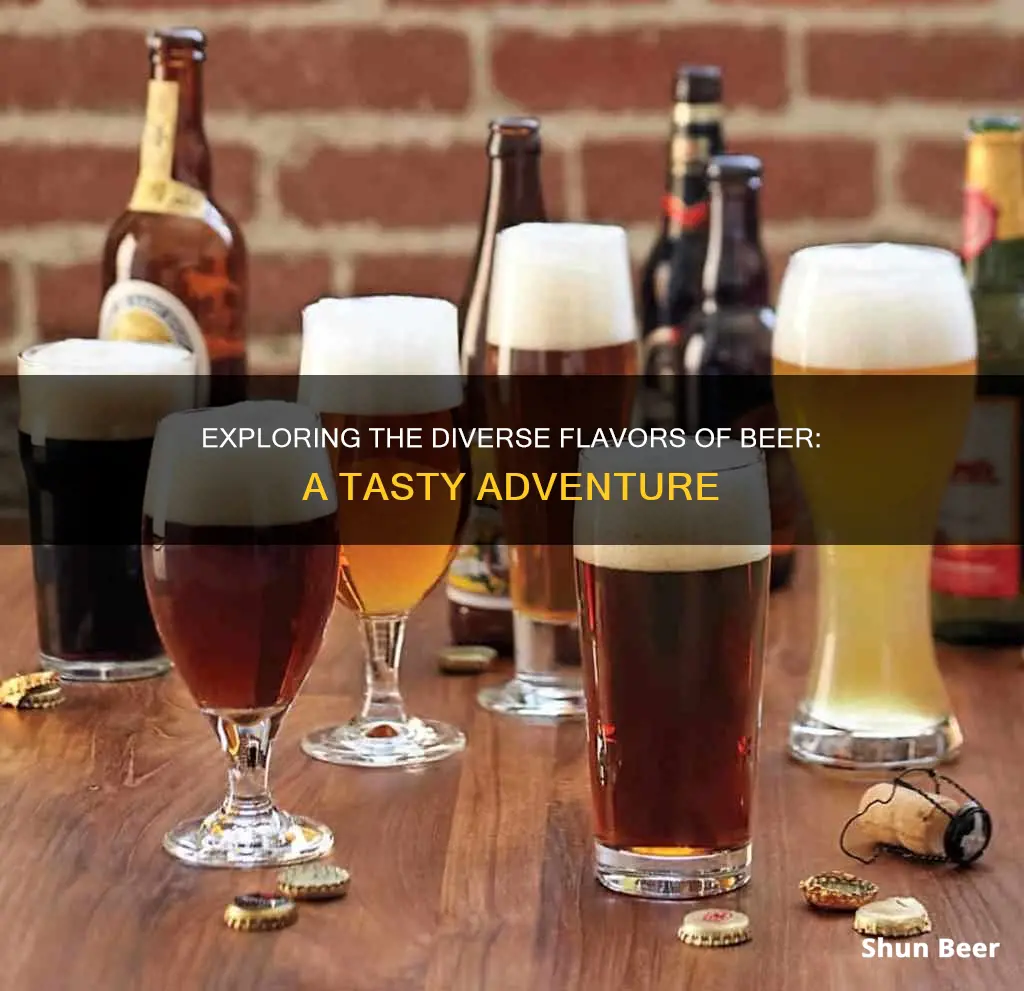
Beer is one of the most widely consumed alcoholic beverages in the world, with a rich history dating back to ancient civilizations. With thousands of craft breweries worldwide, the variety of beer flavours is vast and ever-growing. The different types of beer can be broadly categorised into two main types: lagers and ales. Lagers are clean and refreshing, typically served cold, while ales are more complex, often served at room temperature, and have a rich aroma and flavour. However, within these two main categories, there are numerous sub-styles and flavour profiles to explore. From the crisp and bitter to the sweet and malty, the robust and roasted to the fruity and spicy, the world of beer offers something for every palate.
What You'll Learn
- Crisp beers: These are lighter, cleaner in flavour, and range in colour from straw to amber
- Hop-forward beers: These beers are dominated by the bitter, aromatic qualities of hops
- Malt-accented beers: These beers lack fruit and spice aromatics, instead showcasing bready, biscuity malt flavours
- Roast-forward beers: These beers are made with highly roasted malts, giving them coffee and cocoa flavours
- Fruit and spice beers: These beers have bold fruit and spice flavours, sometimes added to accentuate these qualities

Crisp beers: These are lighter, cleaner in flavour, and range in colour from straw to amber
Crisp beers are characterised by their light, clean, and refreshing flavour profile. They are typically straw to amber in colour, with low to medium alcohol by volume (ABV) and light to medium body. Crisp beers are often served with spicy cuisines, light seafood, leafy greens, salads, sushi, and roast chicken.
Notable styles of crisp beers include Cream Ale, English Blond Ale, American Blond Ale, Wheat Ale, and Kölsch. These beers are known for their subtle fruit flavours, such as green apple, berries, or pear, which come from the use of ale yeast.
Crisp beers can also be malt-accented, meaning they lack the fruit and spice aromatics typically found in ales and have a milder hop profile than Pilsners. Notable malt-accented crisp beers include Pale Lager, Helles Lager, Amber Lager, Vienna Lager, and Märzen/Oktoberfest.
Another style of crisp beer is characterised by its brisk hoppiness, achieved through the use of German and Czech-grown hops (often referred to as Noble hops). These beers have a drier and snappier finish, with spicy, herbal, and floral aromas. Notable examples include Pilsner, Kellerbier/Zwickelbier, Hoppy Lager/India Pale Lager, and Imperial Pilsner.
Crisp beers are just one of the seven flavour categories of beer, which also include hop, malt, roast, smoke, fruit and spice, and tart and funky. Each category has its own unique flavour profile, aroma, and food pairings, offering a diverse range of options to suit every palate.
Oktoberfest Beers: What Sets Them Apart?
You may want to see also

Hop-forward beers: These beers are dominated by the bitter, aromatic qualities of hops
Beer is one of the world's oldest drinks, with a rich history that dates back to ancient civilizations such as the Sumerians, Babylonians, Egyptians, Greeks, Romans, and Chinese. Today, there are numerous beer styles and flavours available, and understanding these different types is crucial for those in the food and beverage industry.
When it comes to hop-forward beers, the focus is on the bitter and aromatic qualities of hops. Hops are the flowers or cones of the Humulus lupulus plant, and they play a significant role in adding flavour and balance to beer. Hop-forward beers showcase the versatility of hops, with their ability to impart a range of flavours, from herbal and peppery notes to intense tropical fruit flavours like pineapple and melon.
The bitterness of beer is often associated with hops, and this is measured using the International Bitterness Units (IBU) scale. While hops can contribute bitterness, they also offer a wide range of aromatic qualities. Hop-forward beers, therefore, emphasise these qualities, resulting in beers with bold, assertive hop flavours and aromas.
One example of a hop-forward beer is the India Pale Ale (IPA). IPAs are known for their high hop bitterness, which provides a distinct and intense flavour profile that can include floral, citrus, or piney notes. American IPAs, in particular, tend to be more hop-forward than their English counterparts, with higher alcohol content and more pronounced bitterness.
Another factor that influences the hop-forward character of a beer is the timing of hop additions during the brewing and fermentation process. In hop-forward beers, hops are often added at multiple stages to enhance both the bitterness and the aromatic qualities of the final product. This results in a complex interplay of flavours and aromas that showcases the versatility of hops.
When pairing hop-forward beers with food, it is essential to consider the intensity of the beer's flavours. Hop-forward beers pair well with aged or hard cheeses, fried foods, burgers, rich or intense meats, and deli sandwiches. The bitterness and aromatics of the hops can cut through the richness of these foods, creating a harmonious dining experience.
In conclusion, hop-forward beers are characterised by the dominant presence of hops in both flavour and aroma. Brewers carefully select hop varieties and add them at specific stages of the brewing process to create beers that showcase the diverse range of flavours and aromas that hops have to offer. Understanding hop-forward beers is crucial for beer enthusiasts, brewers, and those in the food and beverage industry, as it allows for a more nuanced appreciation of the complex world of beer.
Beer Size Matters: How Larger Brews Differ
You may want to see also

Malt-accented beers: These beers lack fruit and spice aromatics, instead showcasing bready, biscuity malt flavours
Beer is one of the world's oldest alcoholic drinks, with a rich history involving many ancient civilisations, from the Sumerians to the Babylonians, Egyptians, Greeks, Romans, and Chinese. Today, there are thousands of craft breweries across the globe, each with its own unique beer styles and flavours. While there are two main categories of beer—ales and lagers—the possibilities for flavour profiles are endless.
One flavour category that showcases the complexity of beer is the malt-accented style. These beers lack the fruit and spice aromatics commonly found in ales, and instead offer a milder hop profile than pilsners. Malt-accented beers are all about the malt, with a full bready, almost biscuity, flavour that adds a crisp, refreshing quality to the brew.
The distinctive flavour of malt-accented beers comes from the use of biscuit malt, a type of highly flavoured specialty malt. Biscuit malt is produced by roasting germinated, kiln-dried barley at high temperatures for a short period of time, resulting in a unique toasted, warm bread, and nutty flavour. This style of malt is created using a drum roaster, an invention that came about during Britain's Industrial Revolution in the early 1800s.
Biscuit malt is commonly used in brown ales, where it can make up as much as 10%–15% of the total grist bill. However, it can also be added in smaller quantities to other beer styles, such as pale ales, amber and red ales, lagers, and bock and Oktoberfest/Märzen beers, to add subtle flavour and aroma. In darker beer styles, such as stouts and porters, biscuit malt can be used sparingly to increase complexity and enhance the malt aroma.
While some people love the unique flavour that biscuit malt imparts, others may find it too overwhelming if used in excess. As with any ingredient, the key is moderation. When used responsibly, biscuit malt can add a complementary, biscuity maltiness to a beer, rounding out the flavour and making low-gravity beers seem bigger. However, in high-gravity beers, it's important to use biscuit malt sparingly to avoid creating an overly malty or cloying perception.
Hard Cider vs Beer: What's the Difference?
You may want to see also

Roast-forward beers: These beers are made with highly roasted malts, giving them coffee and cocoa flavours
Roast-forward beers are characterised by their use of highly roasted malts, which lend a coffee or cocoa flavour to the final product. These beers can range from medium-light to full-bodied, and from deep copper to black in colour. They can also vary in alcohol content, from low to high ABV.
The roasting process involves heating the malts to very high temperatures, generally above 400°F (200°C). This process results in very few fermentable sugars remaining in the malt, which means that while they provide plenty of colour, body, and flavour, they yield little in terms of fermentables. The roasting process also creates unique colours, flavours, and aromas through intense Maillard reactions—the chemical reaction of amino acids and reducing sugars, and/or the caramelisation of sugars at high temperatures.
The roast malt group includes pale chocolate, chocolate malt, carafa I, II and III, black patent malt, red malt, and stout roast. Chocolate malts are commonly used by beginning extract brewers to make darker beers, and they provide a dark roasted flavour to any beer with varying degrees of tannins and harshness. Black patent malt, on the other hand, is smoother and less harsh than chocolate malt. It is often used in small percentages to add colour and a bit of roast flavour to a lighter beer, or layered with other dark malts to create a robust porter or strong stout.
When it comes to food pairings, roast-forward beers go well with grilled or blackened pork, poultry, game, seafood, dessert, barbecue, and raw shellfish.
Exploring Beer and Mead: What Sets Them Apart?
You may want to see also

Fruit and spice beers: These beers have bold fruit and spice flavours, sometimes added to accentuate these qualities
Fruit and spice beers are characterised by their bold fruit and spice flavours, which can be naturally occurring or added to accentuate these qualities. They may be sweet, semi-dry, or dry, but they are never overtly bitter. The ABV of these beers can range from low to high, the body is low to high, and the colour ranges from golden to dark brown.
Fruit and spice beers can be further divided into two categories: bright and dark. Bright fruit and spice beers exhibit brighter fruit qualities, such as apple, pear, peach, orange, lemon, banana, and apricot. They may also feature spices like clove, pepper, vanilla, and coriander. Stronger versions may show malt notes of toffee, caramel, and toast. Notable styles in this category include Kristalweizen, Witbier, Hefeweizen, Belgian Blond Ale, Saison, Gruit Ale, Belgian Strong Blond Ale, and Belgian Strong Pale Ale.
On the other hand, dark fruit and spice beers showcase darker fruit qualities, such as fig, raspberry, prune, raisin, cherry, plum, and strawberry. These beers may also have spicy aromatics like clove, pepper, rose, nutmeg, cinnamon, and a hint of smoke. Malt flavours such as chocolate, caramel, and nutty notes are also present. Notable styles in this category include Dunkelweizen, Belgian Dark Ale, Dubbel, Belgian Strong Dark Ale, and Weizenbock.
When pairing fruit and spice beers with food, consider options like crab, mussels, lobster, lighter fish, cured meats, sausages, salads, poultry, pizza, and spicy cuisines. The versatility of fruit and spice beers allows them to complement a variety of dishes and satisfy a range of taste preferences.
Anheuser-Busch's Wide World of Beers: How Many Varieties?
You may want to see also
Frequently asked questions
The two main types of beer are lagers and ales. Lagers are clean and refreshing, typically served cold, and are the most common beers in America. Ales are more complex, often served at room temperature, and have a rich aroma and flavour.
Examples of ales include Pale Ale, India Pale Ale (IPA), Brown Ale, Irish Beers, Scottish Style Ales, Bock, Porter, and Stouts.
Examples of lagers include Dark Lagers, Wheat Beers, and Pilsner.
There are also hybrid beers that are neither ales nor lagers, such as creamy ales (dark) and kolsch (light). Additionally, there are wild or sour ales that are spontaneously fermented.
There are believed to be over 100 different styles of beer in the world, and this number is constantly growing.







